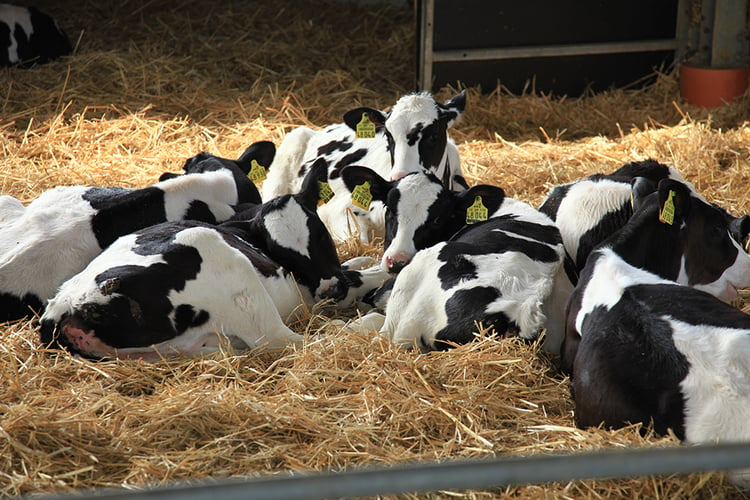- LifeStart
- Calf to heifer
Key takeaways from the research:
- Holstein dairy calves on LifeStart calf feeding schedules reach the desired bodyweight at first insemination at an earlier age
- A LifeStart calf rearing programme increases dairy farm profitability because it results in a reduction of age at first insemination, age at conception and age at first calving

Elevated levels of pre-weaning nutrition reduce the age at first insemination and the age at first calving
The number of young stock and the number of dry cows combined often represent half of the animals on a dairy farm. This means that at any given time, up to half of the animals on the farm do not produce milk. To improve this ratio between animals producing milk and those not producing milk, two key performance parameters should be managed:
• The age at first calving should be reduced
• The level of involuntary culling during lactation should go down
Several authors[1,2,3,5] have shown that elevated levels of pre-weaning nutrition can improve the fertility of heifers and reduce the age at first calving. TN runs a LifeStart research programme on the Kempenshof farm. Fertility results of this trial are presented in this article.
Material and methods
A total of 86 female Holstein dairy calves were included in the study. Pairs were fed the same amounts of colostrum from the same source and blocked by colostrum, parity and season. They had ad libitum access from day 4 onwards to water, starter feed and straw and were all weaned according to a standard protocol at 56 days of age. From day 70 onwards, they were moved to group housing. The only difference between the two groups was the amount of calf milk replacer fed. The LifeStart group was fed 8 litres per day compared to 4 litres per day for the controls, both groups were fed at a concentration of 150 g/l.
Age at first insemination, age at conception and age at first calving were recorded for all dairy calves included in the study.
Results
The LifeStart feeding schedule resulted in an increase of pre-weaning average daily gain of 155 g/day. As a result, the heifer calves reached the desired body weight for the first insemination earlier, resulting in an improvement of fertility. Age at conception was significantly reduced by LifeStart feeding and the difference was maintained until first calving (see table 1).
Conventional (n=39) |
LifeStart (n=42) |
Difference |
P-value |
|
| 1st insemination | 399 days | 393 days | 6 | 0.39 |
| Age at conception | 424 days | 408 days | 16 | 0.04 |
| Age at 1st calving | 699 days | 684 days | 15 | 0.10 |
Table 1: Fertility parameters in Holstein dairy heifers reared with a LifeStart feeding schedule compared to heifers reared on a restricted feeding schedule.
Discussion and conclusion
Farmers often use bodyweight development as the key indicator that dairy calves are ready to be inseminated for the first time. The Holstein dairy calves included in this study grew faster as a result of a LifeStart feeding schedule with elevated planes of pre-weaning nutrition. The age at which the oestrus cycle started in the heifers included in this study was not recorded. A study by Bruinjé et al[4] showed that puberty starts at an earlier age in Holstein dairy calves with higher growth in the pre-weaning period and the period immediately post-weaning.
References
[1] Bolt, A. 2019, Meta-analysis to calculate the effect of rearing intensity on functionality of dairy cows, Research paper Mecklenburg Vorpommern Landesforschungsanstalt für Landwirtschaft und Fischerei.
[2] Bar-Peled et al., 1997. Increased weight gain and effects on production parameters of Holstein heifer calves that were allowed to suckle from birth to six weeks of age. J. Dairy Sci; 80:2523-8
[3] Heras Sánchez, J, Effects of feeding a calf milk replacer with elevated levels of fat on average daily gain and fertility, 2020, Proceedings of the 2nd European Calf Conference.
[4] Bruinjé, T.C, Rosadiuk, J.P, Moslemipur, F, Carelli, J.E, Steele, M.A. and D.J. Ambrose, 2019, Carryover effects of pre- and postweaning planes of nutrition on reproductive tract development and estrous cycle characteristics in Holstein heifers. J. Dairy Sci. 102.
[5] Heras Sánchez, J, Effects of feeding a calf milk replacer with elevated levels of fat on average daily gain and fertility, 2020, Proceedings of the second European Calf Conference



